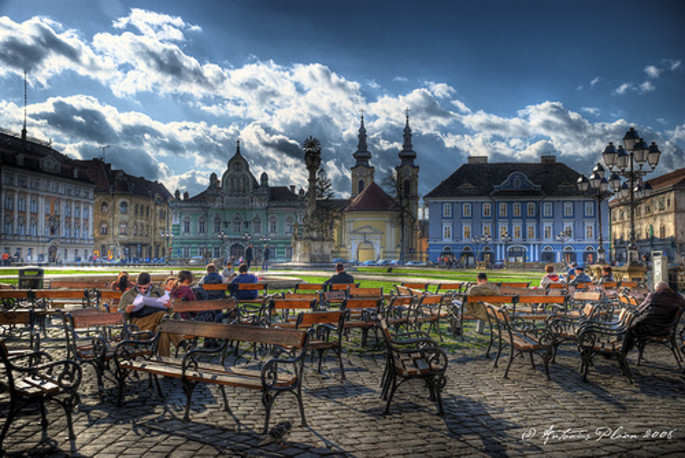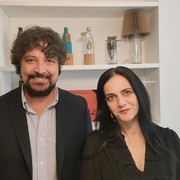The most beautiful and important squares of the city, taking into account the structure of the old fortress of Timisoara, are Plevnei Square, Victoriei Square, Libertăţii Square and Unirii Square.
Plevnei Square is an old square in Timisoara that preserves today the scent of a special charm. The square contains exquisite palaces with architectural elements of the 1900s, called the Secession style in Romania, a style that uses different animals, plants, flowers forms on a dynamic undulating form. This square was born with the introduction of the new town plan that included the expansion of the city beyond the walls. Here it can be admired the splendid palaces designed by Martin Gemeinhardt, famous architect of the time, that he hadn’t designed many buildings but every time he inaugurated a new one was a real event. Before he took this form, this place served as pig market and it was collocated outside the city walls on a square of 950 meters, where it was forbidden to build anything on this space free of trees, all for safety reasons for the city. This square has been kept until 1892 when the administration of the city have obtained the approval of the Court of Vienna for the demolition of the city’s fortifications and so begin to build beyond the city limits.
Not far from this square comes the Victoriei Square, which is also the city's central square. The square’s architecture style is reflecting the beginning of 1900’s because it was situated on the square of about 950 meters outside the city walls. Once it has been approved the enlargement of the city they began to build the buildings that make up the square. Loyd Palace was the first building built and the last are the buildings built after the wars. The most important buildings are undoubtedly the Opera House and the Orthodox Cathedral, which were placed opposite each other.It must be said that, that at the beginning of sec.XX on the place of the center was the swamp and in few years has experienced a radical change.
A few meters away is Libertăţii Square, a square that was part of the fortress, also known under the name of Parade Platz, because it had a military role. As important buildings there is to appoint the Town Hall which was used only by the German community, while the Romanian and the Serb community had their own municipality; three buildings with military functions certificates already since 1727 in which one hides the story of an impossible love between Ludwig van Beethoven and a beautiful 17-year-old singer Jeanette Honrath; the statue of Saint Mary in the center that dominates the square.
The Unirii Square, with its Baroque expression, is undoubtedly one of the most beautiful squares of the city, dominated by the Catholic Cathedral and Serbian Orthodox Cathedral placed opposite to each other. The square receives the form that can be seen today in the late 18th century, and with regard to its size, 150 mx 100 m, was considered a very large square in relation with the surface of the fortified city of that time.
During the course of three centuries has become the place of religious events, military parades and other events, of political and cultural prestige. The square’s main architectural style is the baroque that intertwines with the classic style and the 1900’s style. Today the square represents the most important choreography of baroque architecture of the city.
Besides the two churches that dominate the square, there is also the Baroque Palace, whose construction began in the middle of the 18th century and which hosted, during its existence various institutions in the city and is now the headquarter of the art museum of Timisoara. The building interweaves the Baroque and Rococo style, and lives in perfect harmony with the other buildings of the square, all together creating a show in an "outdoor living room".
Unirii Square is a whole of architecture that reflects in the best way the open and tolerant spirit of Timisoara. Starting from the position, facing each other, the two main churches belonging to two different confessions of the city, it would have been an impossible task in the France of the eighteenth century.
On the west pediment of the square is the residence of the Serbian Orthodox Bishop, whose facade, originally Austrian Baroque style, was remodeled between 1904 and 1905, in a style closer to the Serbian national style by the architect Székely ,a one hundred percent Hungarian. On the same side of the square, on the building in the classical style of the Orthodox community existing in the years 1821-1828, the architect Sturza, descendant of a family of princes and famous intellectuals in Moldova, built in 1983 a pediment in Austrian Baroque style.
So we end up saying that, a Hungarian built in "Serbian" style, while a Romanian built in "Austrian" style, and everything happens in a time when the governments of Budapest and Bucharest were animated by strong aggressive nationalistic-chauvinist manifestations, but that did not echo in the spirit of Timisoara.
Timisoara is definitely the most cosmopolitan city from Romania.Over ten ethnic communities live here in perfect harmony, including Hungarians, Germans, Serbs, Italians, Bulgarians, and so on.
It is the most eloquent example of a society where cultural diversity is a door to new dialogues, where the fact of understanding the other person supposes to move from a simple tolerance toward the acceptance and the celebration of the diversity richness that exists in each of us.
Links:




























